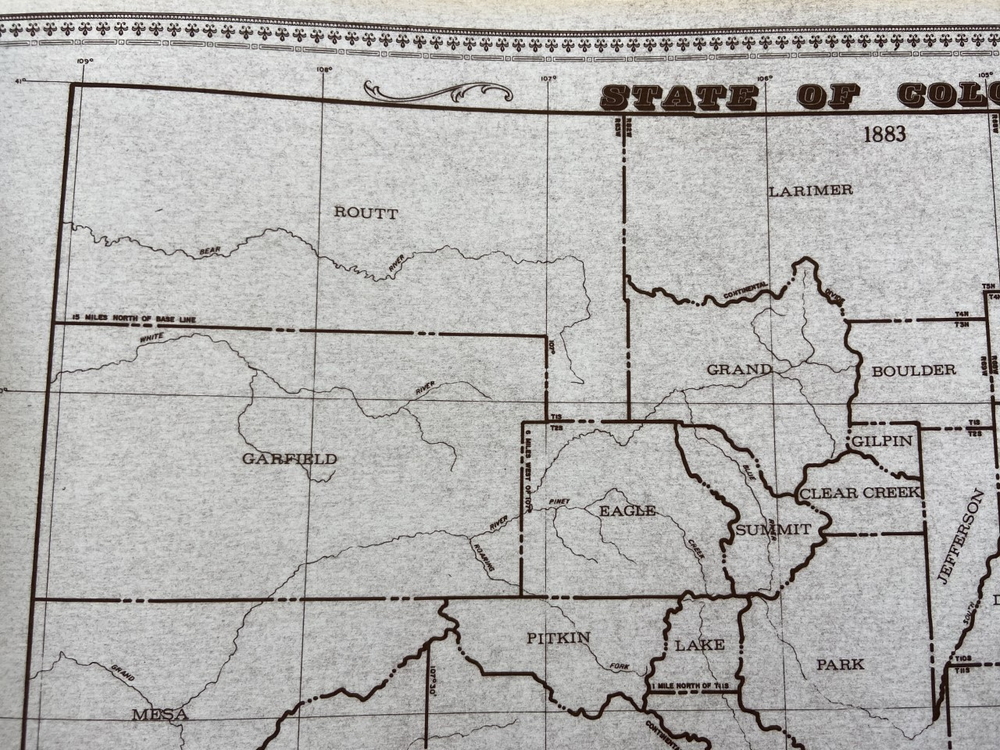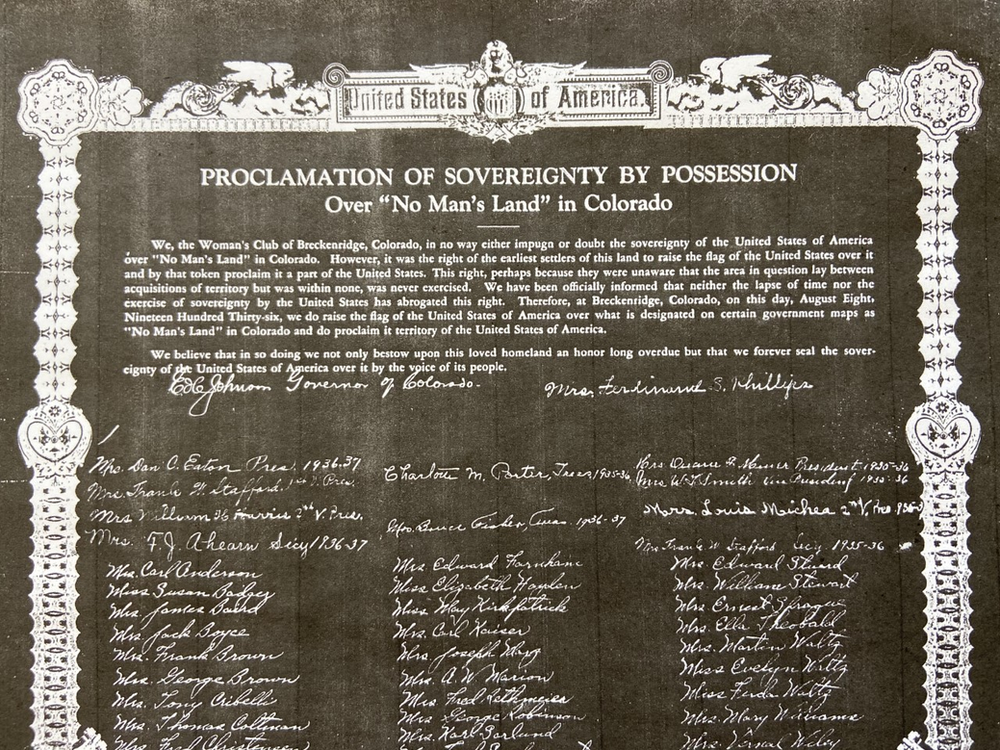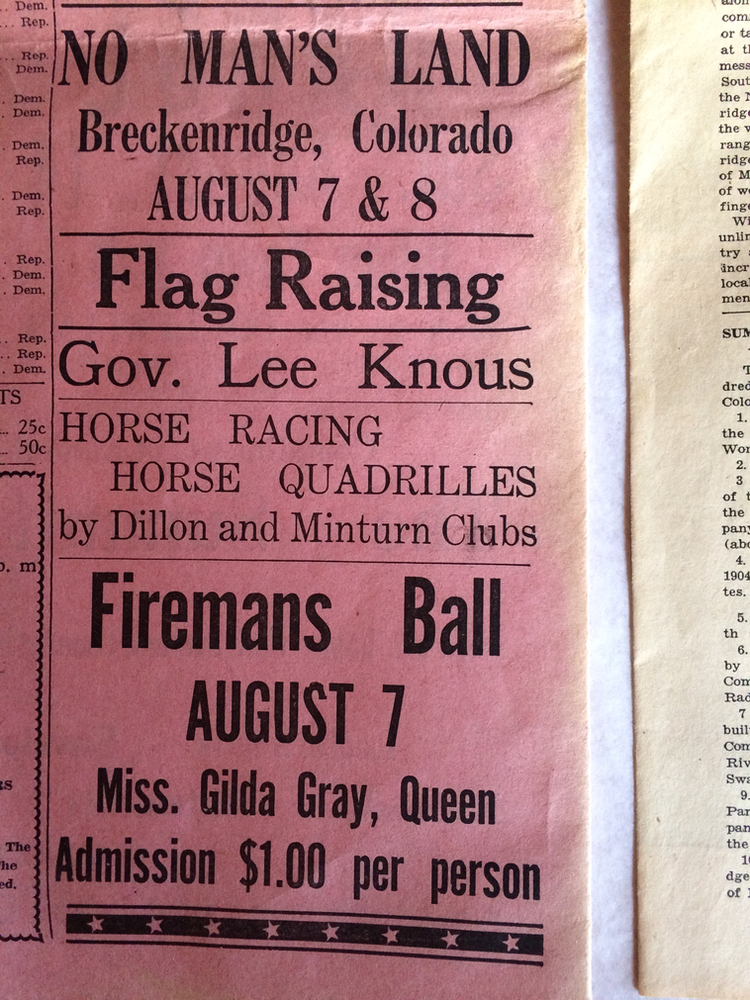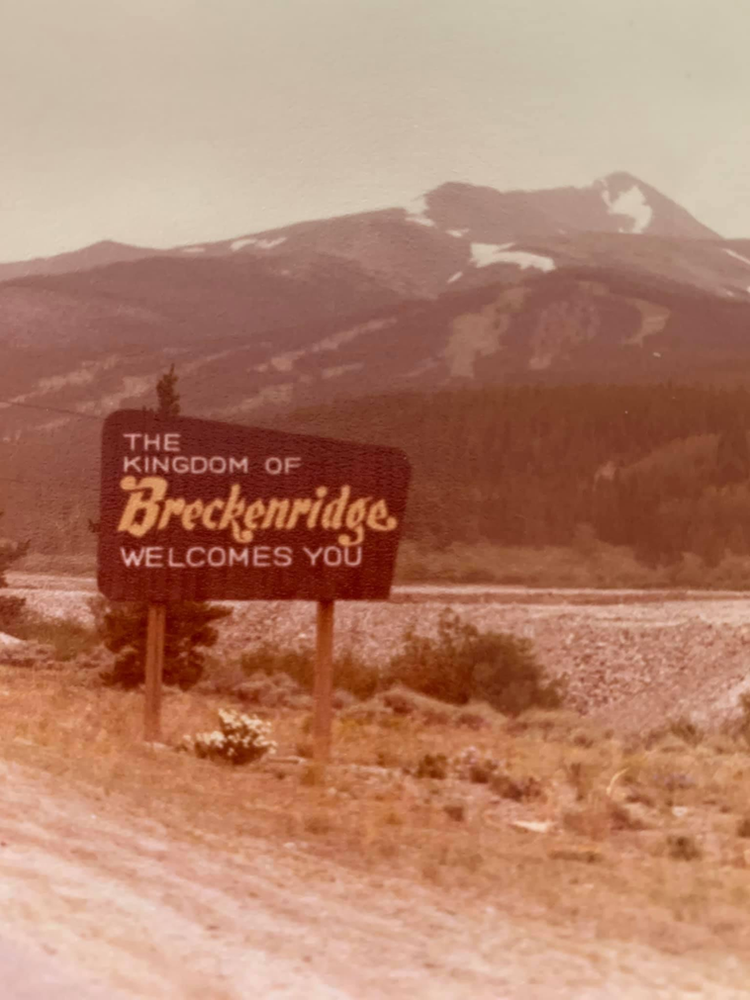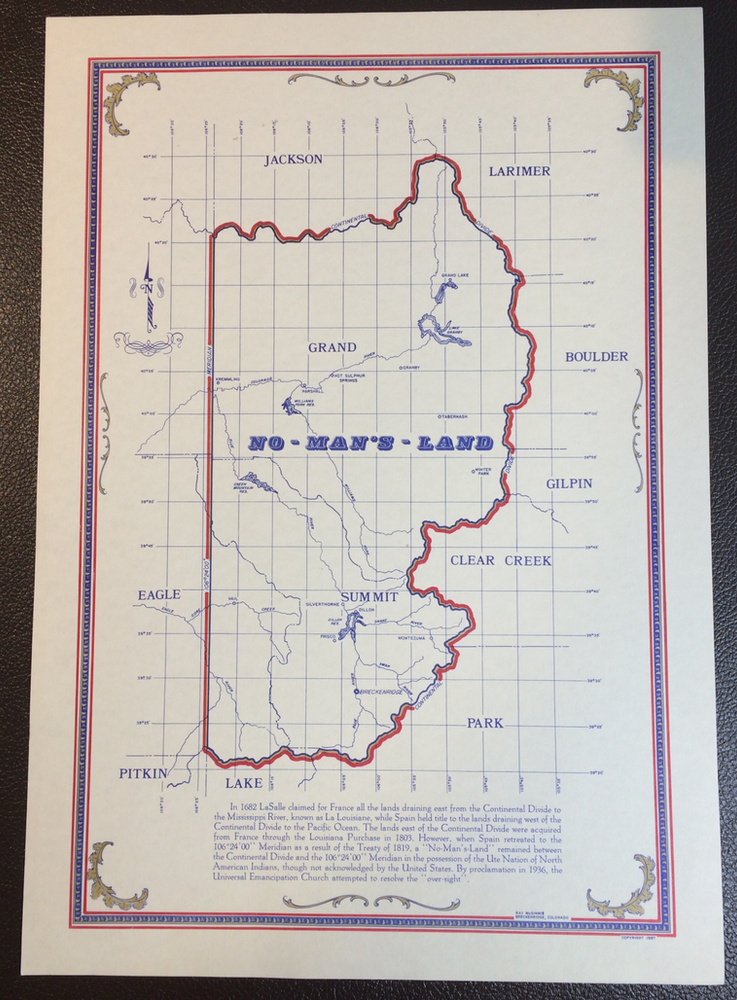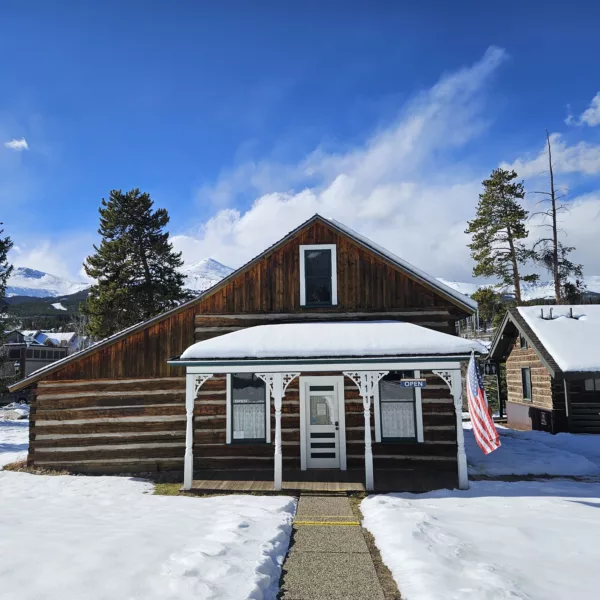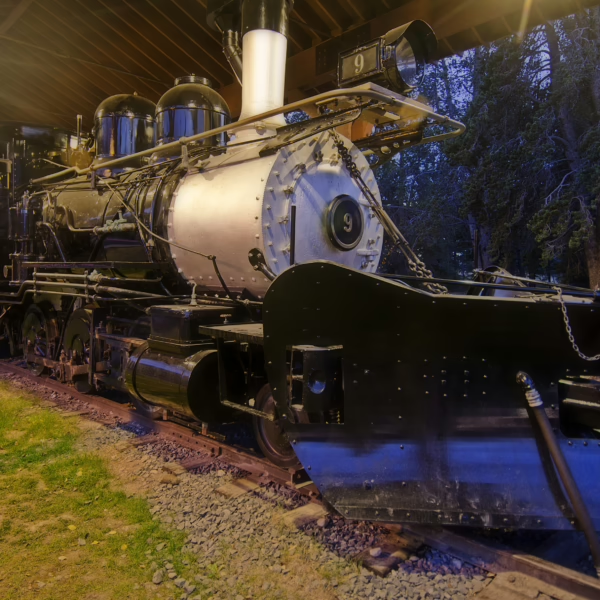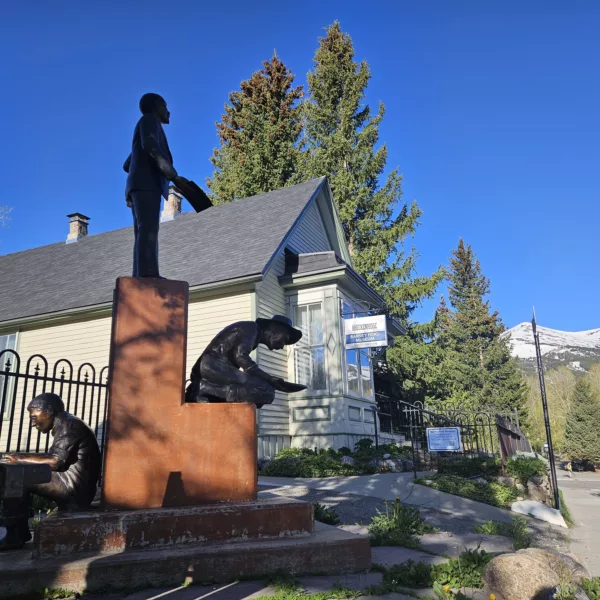Breckenridge’s No Man’s Land Celebration– An Excuse for a Party
March 17, 2021 | Category: Our Collective History
Breckenridge loves a party and celebrated No Man’s Land Festival for decades. Every August, locals and former residents would gather to rekindle friendships and remind each other why Breckenridge was so special. What was No Man’s Land and how did it shape Breckenridge today? Learn how the community’s fascination with boundaries and maps led to many of today’s cultural touchpoints, including Breckenridge’s famed winter carnival, Ullr Fest.
Established in 1859, Breckenridge is the oldest town on Colorado’s Western Slope. As the Summit County seat, Breckenridge once oversaw a vast expanse. One of the original 17 counties of the Territory in 1861, Summit County occupied the entire northwest corner of Colorado. As Colorado grew, Summit County shrank. Over time, the State carved neighboring counties like Grand and Eagle out of the original Summit. By 1883, Summit County was one of the smallest in the State.
Every town wants to be special, to have a claim to fame. In early Colorado, communities jostled for position, even stealing the county records to take the county seat, as the people of Breckenridge did in 1861. For many mining camps, survival was the greatest accomplishment. For other towns of greater ambition, they sought to be the first, the richest, or the most innovative.
By the time of the Great Depression of the 1930s, Breckenridge’s claims to fame were rapidly dwindling. Mines were closing. The railroad would soon shut down. People moved away in droves. Breckenridge’s fame as the greatest gold placer mining ground in Colorado meant little, as the gold was cleaned out and the last of the dredge boats threatened to devour the town.
Would Breckenridge survive? Or would it go the way of hundreds of mining camps and towns that were once thriving, and now all but disappeared?
The ladies of the Women’s Club sought to ensure Breckenridge’s place in Colorado history by answering a critical question: when was Breckenridge and the land around it admitted to union with the United States? Was it the Louisiana Purchase of 1803? Or the annexation of the Republic of Texas in 1845? Or the Treaty of Guadalupe Hidalgo which ceded lands of Mexico to the United States in 1848?
Their research revealed a peculiarity of geography that excluded Breckenridge, they claimed, from any previous treaty or acquisition.
East of Breckenridge, the Continental Divide swoops toward the Mississippi River. To the west, a longitudinal line that corresponds with the headwaters of the Arkansas River defined another treaty boundary. In between lay a parcel of territory that was never made part of the United States. It was a No Man’s Land!
In 1936 the Women’s Club rectified this grave error by planning a spectacle to unite Breckenridge with the country. The whole community got behind the event. County commissioners pledged personal donations to help cover the costs. The Summit County Journal encouraged participation: “We are the only people in the entire United States that can stage such an event…”
As the big day approached, patriotic fervor gripped the people of Summit County. In anticipation, the Journal chimed: “Tomorrow…a ceremony that will bring our homes into the union and that will forever bring all lands involved under the protection of the American Flag, which will, for the first time, officially, bless it with its waving shadow.”
In preparation, the ladies engaged KOA Radio to broadcast the ceremony across the country, never mind that the people of Summit County were yet unable to receive radio signals themselves.
On August 8, 1936, Governor Ed Johnson, for whom the Eisenhower-Johnson Tunnel would later be named, came to dusty Breckenridge to raise the flag of the United States over town. With patriotic splendor, dignitaries made speeches, Naval guns blasted, a military brass band marched to their music, and people cheered as the flag went up. Governor Johnson’s speech boosted the dim prospects of the economically depressed community, extolling the “Vast Natural Treasure Vault” of Summit County, and praising its gold, ranching, timber, fishing and hunting.
Attendees at the Flag raising ceremony included County Treasurer and Mayor of Breckenridge, George Robinson, who served as Master of Ceremonies. Representing the Army was Captain H.D. Stetson of Fort Carson. Navy Lieutenant R.J. Bellerby fired off a naval gun that was heard for miles. Members of the Reserve Corps, National Guard, and veterans of the Spanish War and World War enjoyed a place of honor. Elected officials represented neighboring towns and counties. And a most curious guest was listed, the Warden of the reformatory at Buena Vista.
Harold Rutherford was a young boy when he attended the Flag Raising ceremony. In his charming autobiography, Dustbowl to Paradise, he recalled the day as “…one of the biggest events to ever hit Summit County.” In all the excitement, Harold fainted, and his mother wouldn’t allow him to play the games set up for the children.
But a shadow cast a gloom over the ceremonies. Shortly before the big day, State Historian LeRoy Hafen informed the Women’s Club that the No Man’s Land was indeed included in the Union thanks to the Florida Treaty of 1819. Undaunted, the party proceeded. Perhaps the Women anticipated Hafen’s news, as their proclamation included the hedge: “..what is designated, on certain government maps…”
Over the following decades, the No Man’s Land celebration carried on under different names. Sometimes it was the Flag Raising Ceremony, other times it was a Homecoming. In 1948, they threw a big party, perhaps reflecting optimism after the end of the Second World War. Famed Shimmy Queen, Miss Gilda Gray, danced at the Fireman’s Ball. Miss Gray made such an impression on the community that fifteen years later the Summit County Journal noted so many skiers in February 1963, it was the “biggest crowd that the town of Breckenridge has seen since the appearance of Gilda Gray in 1948.”
In 1959, acknowledging the Town’s centennial, the No Man’s Land party included such goofy events as a Beard Beauty Contest and the Pink Poodle Posse. Continuing the tradition of inviting dignitaries to the celebration, guests of honor included U.S. Supreme Court Justice Hugo Black and his wife, and Ford Frick, U.S. Baseball Commissioner.
In the early days of Breckenridge as a ski town, the No Man’s Land Festival became another homecoming. Longtime resident Erin McGinnis recalled that people would come back to town to reconnect with old friends. It was an event for “locals who were invested in the community to share comradery,” she said.
As Breckenridge matured into a tourist destination, the Resort Chamber took over No Man’s Land. It was no longer an event for locals, but another way to draw tourists to town. Activities included musical performances, art shows, chainsaw wood sculpture contests, and gold panning championships. In 2000, Breckenridge celebrated the last No Man’s Land Festival. After 64 years, No Man’s Land was deemed irrelevant.
Yet the legacy of No Man’s Land continues today with Ullr Fest and the Kingdom of Breckenridge. In 1963, as the people of the young ski town of Breckenridge determined how to bring in more visitors, they planned the winter carnival of Ullr Dag. Protesting the efforts of the Women’s Club twenty-seven years prior, they claimed that Breckenridge was never part of the Union and therefore entitled to be the Kingdom of Breckenridge. Ullr Dag included a King and Queen, visas to enter town, and their own coinage for currency. Learn more about the early Ullr Dag festivals at the BHA Blog site.
Breckenridge loves to party and has long found creative ways to kick up its heels and let loose. From the miners’ stag dances, to the Women’s Club’s No Man’s Land, to Ullr Fest today, Breckenridge knows how to have fun.
Learn more about Breckenridge history by visiting a Breckenridge History museum, taking a tour, or reading blog articles.
Written by Leigh Girvin



